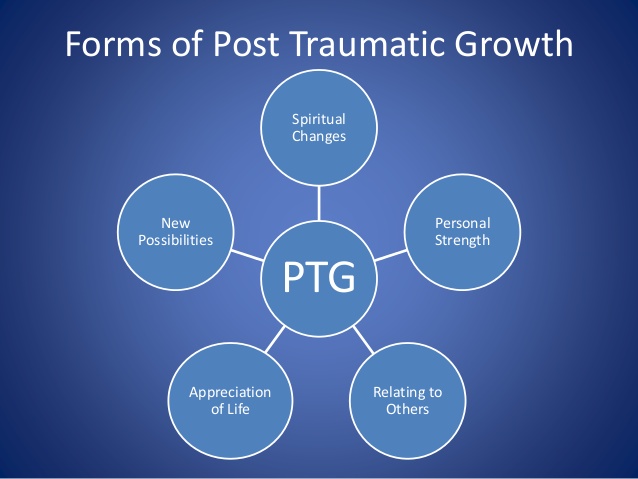Many human beings experience potentially traumatic events in their life whether it is community violence, severe accident, combat exposure, life-threatening situation, or other kinds of abuse or trauma.
Old researches have focused on the development of mental health problems after a trauma, such as anxiety disorders, post-traumatic stress disorder, or acute stress disorder.
However, not all individuals develop psychological state problems after a trauma, and a few actually may experience what researchers call “post-traumatic growth.”
WHAT’S IN IT
What is post-traumatic growth?

Post-traumatic growth (PTG) is positive personal changes that result from the survivor’s struggle to affect trauma and its psychological consequences.
So, The process of post-traumatic growth can cause improved relationships with others, more compassion, openness, appreciation for all times, spiritual growth, personal strength, and a renewed sense of possibilities within the world.
This personal growth extends beyond pre-trauma functioning. PTG is not merely a bouncing back to the level of functioning before the trauma, but rather a sense of positive growth beyond pre-trauma functioning.
Importantly, recent research has highlighted that post-traumatic growth isn’t the other reaction thereto of post-traumatic stress; rather these are two separate sorts of responses that will occur within the same person simultaneously. And over time, and that the experience of distress can promote the development of growth.
4 Positive Trauma Therapy Techniques
In positive trauma, therapy treatment includes several techniques that the evidence suggests will aid those suffering from symptoms of PTSD, categorized into four chronological stages of treatment progression: (1) Deal, (2) Feel, (3) Heal, and (4) Seal.
find the primary technique from each of the steps below.
1. Deal – Writing a Trauma Narrative

In the first step, therapists will assign the sufferer an initial exercise that will set the stage for the following steps and facilitate the healing process. This exercise is creating their trauma narrative.
The trauma narrative is that the client’s telling of the story of their traumatic experience. They are often quite difficult to begin, as the emotions by the original trauma can come flooding back as the sufferer recalls the details of the event, but it will get easier as the process goes on.
The sufferer should begin that specialize in the facts – the who, what, when, and where of the experience. Next, they can add thoughts and feelings that arise during the experience. Once they’re comfortable listing or describing their thoughts and feelings during the experience, they ought to advance to the foremost difficult or disturbing moments of their trauma. This will be difficult, but it’s necessary to place together a comprehensive narrative of the trauma. Finally, they suffering should take what they need thus far and wrap it all up and make a seamless narrative, additionally to adding a final paragraph about how they feel now, what they have learned, and if they have grown from the experience.
Complete this exercise individually or with a therapist or counsellor to guide the client through the difficult process. However complete the narrative, the therapist should re-evaluate the exercise with the client once the narrative is finished.
2. Feel – Exposure

As the name of the main technique in this step suggests, this is where the sufferer exposes to the traumatic memory to connect the fragmented cognitive and emotional aspects and facilitate catharsis.
The imaginal desensitization technique applies during this step, during which the client reads his or her trauma narrative.
The therapist guides the client through the processing of the event.
The therapist will then help the client explore their emotional responses and themes that came up during processing.
Discussing the primary feelings associated with the trauma.
After the session, the client has some homework – he or she is going to head home and set a while aside every day to process through the traumatic experience, focusing on purging the emotional aspects of it.
It will likely be emotionally challenging to drag up these memories and tie some intense feelings to them.
But that’s where these emotions belong: with the traumatic experience that spawned them, instead of displaced onto the self or others.
3. Heal – Three Concepts and PTG Channeling
In step three, the focus is on helping the sufferer put the pieces back together.
But during a new and stronger configuration than before.
The therapist will emphasize three concepts to the client:
1. Freedom of choice

The therapist explains that, while the client didn’t prefer to experience the trauma that led them here, they’re on top of things of their choices going forward.
Narrative therapy is the concept of “rewriting the ending” to help the client see that he or she can create their path.
2. Finding meaning from the experience
The therapist discusses how the client can find meaning in their experience, however, is acceptable and feasible for them.
3. The Hero archetype
Finally, the therapist walks the client through the transformative journey.
“Hero archetype by telling stories, tying the client’s spiritual and cultural beliefs into the stories to form them more meaningful for the client.”
The client may enjoy hearing the various stories during which the hero undergoes significant trauma and becomes a far better, stronger person from it.
Once these three concepts are discussed, the therapist can advance to the teaching of therapy that emphasizes goal-setting and goal-striving.
This component is mentioned as PTG channelling because it focuses on the client channeling their emotional energy from reliving or avoiding the traumatic experience into productive, goal-oriented behaviour.
Overall, this step is about the client extracting meaning from their experience and finding their answers and solutions. The therapist may assign more homework as this step wraps up. Instructing the client to travel home and have interaction in one action that illustrates their shift from victimhood to posttraumatic growth.
4. Seal – The Mind is a file
The final step of the PTGP involves docking loose ends and putting the finishing touches on the reorganization of the traumatic memory.
The “mind as a filing cabinet” metaphor may be a great one to use during this step. During this metaphor, the memory of the traumatic experience is likened to an unorganized file, scattered throughout the file that’s the mind. Rather than each component being neatly sorted with the others. They’re separated into dozens of various folders with no rhyme or reason. Making it confusing and potentially disruptive when one among them is inspected.
In the previous three steps, these components were identified, hunted down, and moved to the proper folder. While a couple of new pages were added documenting the expansion experienced through the method.
This step finalizes the folder and files it away within the cabinet.
It is often revisited within the future. But it’s not anything quite another within the hundreds and thousands of files and folders that structure the cupboard.
At now, the client is prepared to maneuver on to a different disorganized file. If there’s another file that needs reorganization.
Whether the therapy will still another file or not. The therapist should commend the client for all of his or her diligence throughout therapy. And encourage them to continue incorporating PTGP into his or her life.
The client should leave feeling empowered over their trauma and prepared to manoeuvre forward with a replacement and improved perspective on life.
Self Managing PTG

If you’ve struggled, or are struggling, after an extreme career or life crisis, you’ll likely recognize a number of the symptoms that we’ve mentioned, et al. like disorientation, mood swings, and flashbacks. If so, the simplest thing you’ll do is seek professional help. ask your HR department or a health care provider.
As we’ve seen, while a trauma can have an enormous emotional and physical impact. The struggle that you simply endure can cause incredible personal change through PTG.
PTG cannot be forced, but you’ll get yourself into the simplest place to nurture it. Following these seven steps will set you on the proper path:
- Begin to think positively about the new you – you’re at the beginning of a replacement stage in life.
- Engage with the planet around you, and appreciate all the great things that it’s to supply.
- Allow yourself time to speak honestly about how you are feeling, particularly with people that have suffered something almost like you.
- Reflect on any aspect of your life where your actions harmed yourself or others, and make positive changes as a result.
- Accept offers of help.
- Help others. for instance, you’ll do volunteer or charitable add your community.
- Be hospitable to new experiences and opportunities, including new friendships.
- combat new challenges or learn new skills.
Conclusion
Post-traumatic growth (PTG) is defined as positive personal changes that result from the survivor’s struggle to affect trauma and its psychological consequences. In positive trauma, therapy treatment includes several techniques. That the evidence suggests will aid those suffering from symptoms of PTSD. That are categorized into four chronological stages of treatment progression: (1) Deal, (2) Feel, (3) Heal, and (4) Seal. Also, there are some symptoms of this which are mentioned in the blog.
Also you can read our blog on Self-motivation: 5 Practical steps to motivate yourself
FAQ’s
Post-traumatic growth (PTG) is defined as positive personal changes that result from the survivor’s struggle to deal with trauma and its psychological consequences.
Yes it works if you perform it seriously
Therapy are four chronological stages of treatment progression: (1) Deal, (2) Feel, (3) Heal, and (4) Seal.



